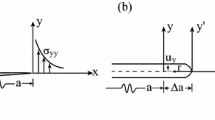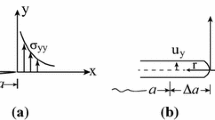Abstract
The recently developed edge-based smoothed finite element method (ES-FEM) is extended to the mix-mode interface cracks between two dissimilar isotropic materials. The present ES-FEM method uses triangular elements that can be generated automatically for problems even with complicated geometry, and strains are smoothed over the smoothing domains associated with the edges of elements. Considering the stress singularity in the vicinity of the bimaterial interface crack tip is of the inverse square root type together with oscillatory nature, a five-node singular crack tip element is devised within the framework of ES-FEM to construct singular shape functions. Such a singular element can be easily implemented since the derivatives of the singular shape term \({(1/\sqrt r)}\) are not needed. The mix-mode stress intensity factors can also be easily evaluated by an appropriate treatment during the domain form of the interaction integral. The effectiveness of the present singular ES-FEM is demonstrated via benchmark examples for a wide range of material combinations and boundary conditions.
Similar content being viewed by others
References
Yeap KB, Zeng KY, Chi DZ (2008) Determining the interfacial toughness of low-k films on Si substrate by wedge indentation: further studies. Acta Mater 56: 977–984
Hutchinson JW, Suo Z (1992) Mixed mode cracking in layered materials. In: Hutchinson JW, Wu TY (eds) Advances in applied mechanics, pp 63–191
Williams ML (1959) The stress around a fault or crack in dissimilar media. Bullet Seismol Soc Am 49: 199–204
England AH (1965) A crack between dissimilar media. J Appl Mech 32: 400–402
Rice JR, Sih GC (1965) Plane problems of cracks in dissimilar media. J Appl Mech 32: 418–423
Rice JR (1988) Elastic fracture mechanics concepts for interfacial cracks. J Appl Mech 55: 98–103
Henshell RD, Shaw KG (1975) Crack tip finite elements are unnecessary. Int J Numer Methods Eng 9: 495–507
Barsoum RS (1976) On the use of isoparametric finite elements in linear fracture mechanics. Int J Numer Methods Eng 10: 551–564
Barsoum RS (1977) Triangular quarter-point elements as elastic and perfectly-plastic crack tip elements. Int J Numer Methods Eng 11: 85–98
Shih CF, Asaro RJ (1988) Elastic-plastic analysis of cracks on bimaterial interfaces: part I-small scale yielding. J Appl Mech 55: 299–316
Matos PPL, McMeeking RM, Charalambides PG, Drory MD (1989) A method for calculating stress intensities in bimaterial fracture. Int J Fract 40: 235–254
Nahta R, Moran B (1993) Domain integrals for axisymmetric interface crack problems. Int J Solids Struct 30(15): 2027–2040
Belytschko T, Black T (1999) Elastic crack growth in finite elements with minimal remeshing. Int J Numer Methods Eng 45(5): 601–620
Moes N, Dolbow J, Belytschko T (1999) A finite element method for crack growth without remeshing. Int J Numer Methods Eng 46(1): 131–150
Belytschko T, Moes N, Usui S, Parimi C (2001) Arbitrary discontinuities in finite elements. Int J Numer Methods Eng 50(4): 993–1013
Sukumar N, Huang ZY, Prévost JH, Suo Z (2004) Partition of unity enrichment for bimaterial interface cracks. Int J Numer Methods Eng 59: 1075–1102
Chen JS, Wu CT, Yoon Y (2001) A stabilized conforming nodal integration for Galerkin mesh-free methods. Int J Numer Methods Eng 50: 435–466
Liu GR, Dai KY, Nguyen TT (2007) A smoothed finite element method for mechanics problems. Comput Mech 39: 859–877
Liu GR, Nguyen TT, Dai KY, Lam KY (2007) Theoretical aspects of the smoothed finite element method (SFEM). Int J Numer Methods Eng 71: 902–930
Liu GR, Nguyen-Thoi T, Lam KY (2008) A node-based smoothed finite element method for upper bound solution to solid problems (NS-FEM). Comput Struct 87: 14–26
Dohrmann CR, Heinstein MW, Jung J, Key SW, Witkowski WR (2000) Node-based uniform strain elements for three-node triangular and four-node tetrahedral meshes. Int J Numer Methods Eng 47: 1549–1568
Liu GR, Zhang GY, Dai KY, Wang YY, Zhong ZH, Li GY, Han X (2005) A linearly conforming point interpolation method (LC-PIM) for 2D solid mechanics problems. Int J Comput Methods 2(4): 645–665
Liu GR, Nguyen-Thoi T, Lam KY (2009) An edge-based smoothed finite element method (ES-FEM) for static, free and forced vibration analysis. J Sound Vib 320: 1100–1130
Nguyen-Thoi T, Liu GR, Lam KY (2009) A face-based smoothed finite element method (FS-FEM) for 3D linear and nonlinear solid mechanics problems using 4-node tetrahedral elements. Int J Numer Methods Eng 78: 324–353
Liu GR, Gu YT (2001) A point interpolation method for two-dimensional solids. Int J Numer Methods Eng 50: 937–951
Liu GR, Zhang GY (2008) Edge-based smoothed point interpolation methods. Int J Comput Methods 5: 621–646
Chen L, Nguyen-Xuan H, Nguyen-Thoi T, Zeng KY, Wu SC (2009) Assessment of smoothed point interpolation methods for elastic mechanics. Commu Numer Methods Eng doi:10.1002/cnm.1251
Shih CF (1988) Cracks on bimaterial interfaces: elasticity and plasticity aspects. Mater Sci Eng A 143: 77–90
Dundurs J (1969) Edge-bonded dissimilar orthogonal elastic wedges. J Appl Mech 36: 650–652
Moran B, Shih CF (1987) Crack tip and associated domain integrals from momentum and energy balance. Eng Fract Mech 27(6): 615–641
Li FZ, Shih CF, Needleman A (1985) A comparison of methods for calculating energy release rates. Eng Fract Mech 21(2): 405–421
Charalambides PG, Lund J, Evans AG, McMeeking RM (1989) A test specimen for determining the fracture resistance of bimaterial interfaces. J Appl Mech 56: 77–82
Author information
Authors and Affiliations
Corresponding author
Rights and permissions
About this article
Cite this article
Chen, L., Liu, G.R., Nourbakhsh-Nia, N. et al. A singular edge-based smoothed finite element method (ES-FEM) for bimaterial interface cracks. Comput Mech 45, 109–125 (2010). https://doi.org/10.1007/s00466-009-0422-3
Received:
Accepted:
Published:
Issue Date:
DOI: https://doi.org/10.1007/s00466-009-0422-3




